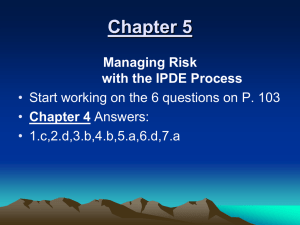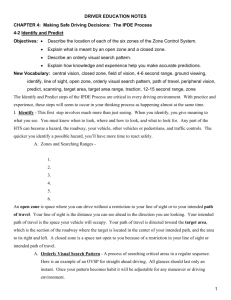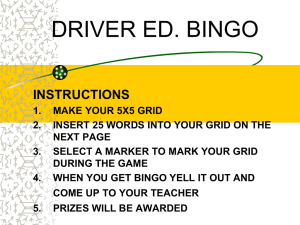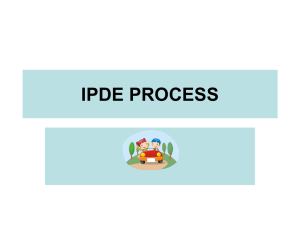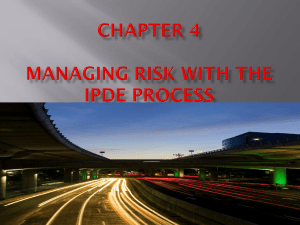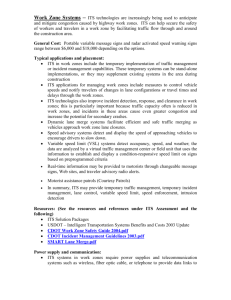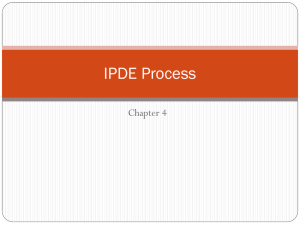CHAPTER 4
advertisement
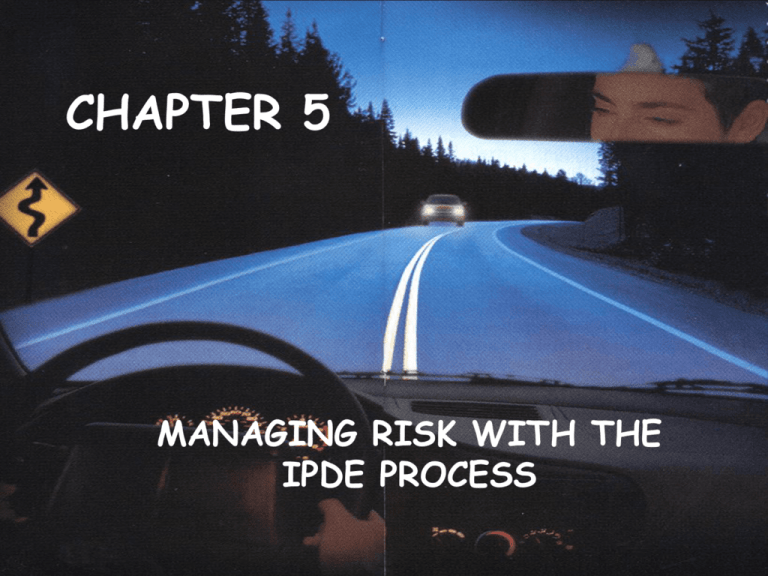
CHAPTER 5 MANAGING RISK WITH THE IPDE PROCESS Essential Question and Vocabulary • EQ: What are some factors that contribute to higher degrees of risk while driving? • Risk Factors – anything that can increase the possibility of a collision. • Zone – one of 6 areas of space around a vehicle that is the width of lane and extends as far as the driver can see • Orderly Visual Search Pattern – process of searching critical areas in a regular sequence Chapter 5 Day 1 • • • • EQ and Vocabulary – 5 minutes Read Chapter 5.1 and 5.2 – 10 minutes Notes – 25 minutes Do pg. 81 (1-3) – 10 minutes FACTORS THAT CONTRIBUTE TO DRIVING RISK DRIVER CONTRIBUTED RISKS: ADJUSTING RADIO BEING ANGRY HAVING BLURRED VISION COMBING HAIR DRINKING WHILE DRIVING USING A CELL PHONE FACTORS THAT CONTRIBUTE TO DRIVING RISK Vehicle contributed risks: Bald Tires Bad brakes Dirty windshield Broken headlights Worn wipers FACTORS THAT CONTRIBUTE TO DRIVING RISK Environment contributed risks: Bright sun Construction Dark shadows Snow and ice Sharp curve THE IPDE PROCESS IDENTIFY: Open and closed zones Clues Other users Roadway features and conditions Traffic controls THE IPDE PROCESS PREDICT: Actions of others Speed Direction Control THE IPDE PROCESS DECIDE: Change or maintain speed Change direction Communicate THE IPDE PROCESS EXECUTE: Control your speed Steer Communicate Combine actions (ie. Multi-tasking) THE SMITH SYSTEM 1. 2. 3. 4. 5. Aim high in steering Keep your eyes moving Get the big picture Make sure others see you Leave yourself an out ZONE CONTROL SYSTEM 1. See a zone change 2. Check other zones 3. Create time and space by getting the best speed control ZONES AND SEARCHING OPEN ZONE: Any zone where you can drive without a restriction. ZONES AND SEARCHING LINE OF SIGHT: The distance you can see ahead in the direction you are looking. ZONES AND SEARCHING PATH OF TRAVEL: The place where you intend to go ZONES AND SEARCHING TARGET AREA: the section of roadway where the target is located in the center of your intended path Closed Zones: A space not open to you because of a restriction in your line of sight or intended path of travel. ZONES AND SEARCHING Target Area Range: The space from your vehicle to the target area. ORDERLY VISUAL SEARCH PATTERN A process of searching critical areas in a regular sequence. Field of Vision Central Vision: Narrow area you can see very clearly directly in front of you. Peripheral Vision: The area you can see to the left and right outside your central vision. Bell Ringer Day 2 • Drivers need to know when, how, where and what to look for while driving. • Write examples on the smart board • Vocabulary: • Scanning – glancing continually and quickly with very brief fixations through your orderly visual search pattern • Compromise Space – giving as much space as possible to the greater hazard Day 2 • After reading Chapter 5.2, get with a partner and do page 91 (1-4) on your own sheet of paper • Notes LOOK FOR OPEN ZONES Look for clues that might lead to an open or closed zone. LOOK FOR OTHER USERS Anyone who might effect your intended path of travel. GROUND VIEWING Glancing at the front tires of approaching vehicles to help predict where they are headed. LOOK FOR ROADWAY FEATURES Hills, Intersections, Curves, etc. CHANGE FROM MULTILANE TO SINGLE LANE •Be prepared to change lanes. •Watch for others changing lanes LOOK FOR TRAFFIC CONTROLS Be prepared to react to them in time. HOW TO PREDICT Requires: •Knowledge •Judgment •Experience WHAT TO PREDICT? Actions of others Your control of your vehicle and the consequences of your actions DECIDE 2 Decisions 1. Decide to change speeds 2. Decide to change direction SPACE CUSHION The area of space all around your vehicle. •Lane position 1 •Lane position 2 •Lane position 3 DECIDE TO COMMUNICATE •Headlights, taillights, brake lights •Turn signals •Parking lights or hazards •Back-up lights •Horn •Car position •Eye contact MINIMIZE THE HAZARD Reduce the possibility of conflict by deciding to put more distance between yourself and the hazard SEPARATE THE HAZARDS Adjusting your speed in order to deal with one hazard at a time. COMPROMISE SPACE Giving as much space as possible to the greater hazard COMMENTARY DRIVING: Thinking out loud while you drive. PRACTICE IPDE IPDE TAKES TIME •The most important thing to remember is that you must have time to see clues, predict actions, decide what to do, and perform the safest maneuver. •Practice in low risk environments first, before moving into busier traffic. Day 3 • • • • • Read Chapter 5.3 Do page 98 (1-3) alone Read Chapter 5.4 Do page 100 (1-2) with a partner Check for correct answers as a class Day 4 • Read Lesson Summaries on page 101 • Do Chapter Vocabulary page 101 – answers only • Do Preparing for the Test page 103 • Take questions and review for Chapter 5 test
